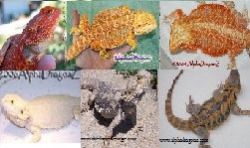Bearded Dragons in the Wild
Bearded Dragons in the wild will eat any plants they can get their teeth around, insects, and if they can catch them small rodents and small lizards. Bearded Dragons will spend a large part of their day climbing up on something and sitting in the sun. When it is cold at night or during the winter, they will burrow underground and sleep to maintain their temperature. They will do the same thing if it gets too hot for them. In winter, they go into something called brumation, which is similar to hibernation. They are only around each other in groups during mating. After they mate, the group will split (they aren't social for the majority of the year, which is why there are problems keeping them together in one enclosure long term). That single mating will give the female multiple groups of eggs, and she will only mate once a year since she retains sperm. They don't form permanent partnerships. The female will go somewhere to lay her eggs after leaving the group, then she will bury them and abandon the site. Once the eggs hatch, the vast majority will never reach adulthood. They have many predators, from birds to dingos to cars.
Below are two maps, the orange and white one shows the distribution of Pogona vitticeps within Australia and the multicolored one shows the type of land in Australia, so you can get an idea of their habitat. Bearded Dragons are only naturally found in Australia.
 Since
the 60's Australia has forbidden export of Bearded Dragons in an effort
to protect the species from the pet trade. There was some initial
smuggling going on, which has now pretty much stopped because Australia
is incredibly good (thankfully) at protecting their unique wildlife. A
lot of the captive population comes from German stock at the present.
From the browns, dull yellows, and reds that match the soil, tons of
different morphs/colors have appeared. Nowadays, the subtle hues of the
wild Bearded Dragons have been exaggerated in the captive ones so that
they are extremely vibrant and beautiful (although normal coloring,
middle second row, is still attractive). The US right now has breeders
focusing on color. Unfortunately, they weren't focusing on health as
much so US bred Bearded Dragons are usually less hardy. Europe,
especially Germany, focused on health and hardiness so they have less
colorful but more robust Bearded Dragons over there. However, nowadays
this distinction is beginning to slip as the two start to mix their
bloodlines together to produce colorful and robust dragons. All Bearded
Dragons are fairly intelligent, as far as lizards go. They each have
their own unique personalities, and are friendly towards humans. They
are smart enough to recognize their owners and their own names
Since
the 60's Australia has forbidden export of Bearded Dragons in an effort
to protect the species from the pet trade. There was some initial
smuggling going on, which has now pretty much stopped because Australia
is incredibly good (thankfully) at protecting their unique wildlife. A
lot of the captive population comes from German stock at the present.
From the browns, dull yellows, and reds that match the soil, tons of
different morphs/colors have appeared. Nowadays, the subtle hues of the
wild Bearded Dragons have been exaggerated in the captive ones so that
they are extremely vibrant and beautiful (although normal coloring,
middle second row, is still attractive). The US right now has breeders
focusing on color. Unfortunately, they weren't focusing on health as
much so US bred Bearded Dragons are usually less hardy. Europe,
especially Germany, focused on health and hardiness so they have less
colorful but more robust Bearded Dragons over there. However, nowadays
this distinction is beginning to slip as the two start to mix their
bloodlines together to produce colorful and robust dragons. All Bearded
Dragons are fairly intelligent, as far as lizards go. They each have
their own unique personalities, and are friendly towards humans. They
are smart enough to recognize their owners and their own namesSource: Akeath2@yahoo.com
http://beardeddragoncaresheet.weebly.com/general-info.html


1 comment:
The first map is from http://reptilesofaustralia.com/lizards/agamids/pvitticep.htm
Post a Comment